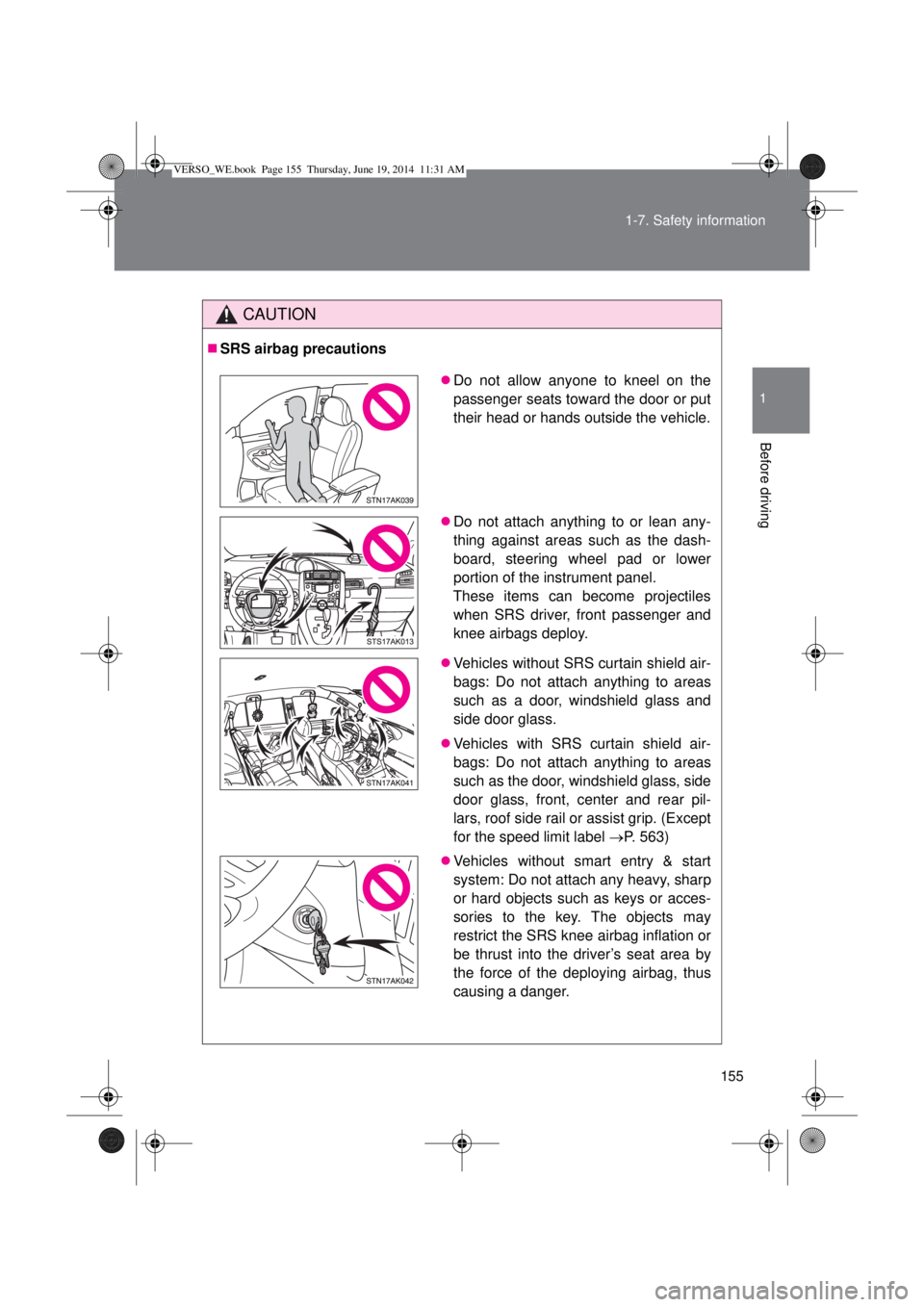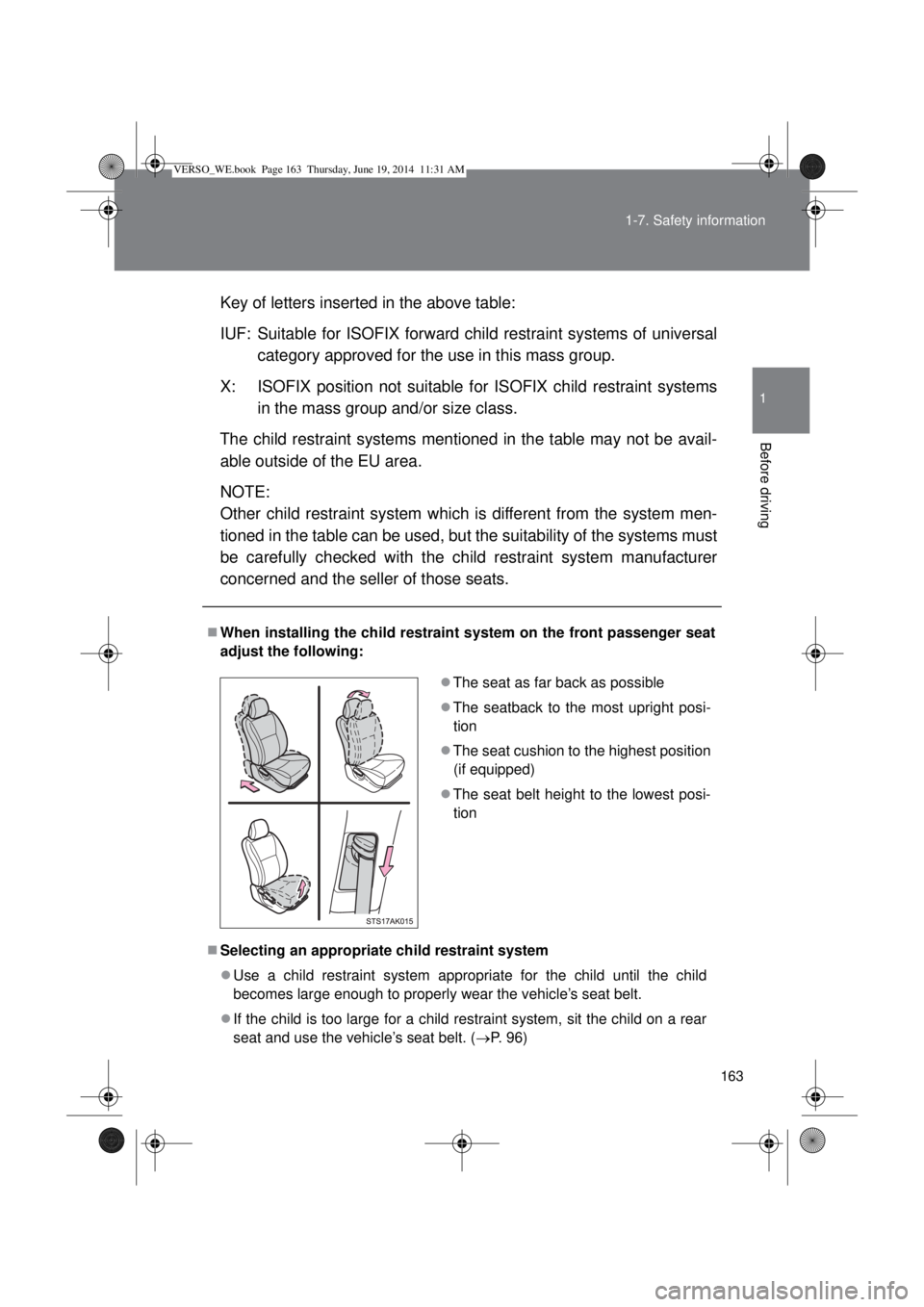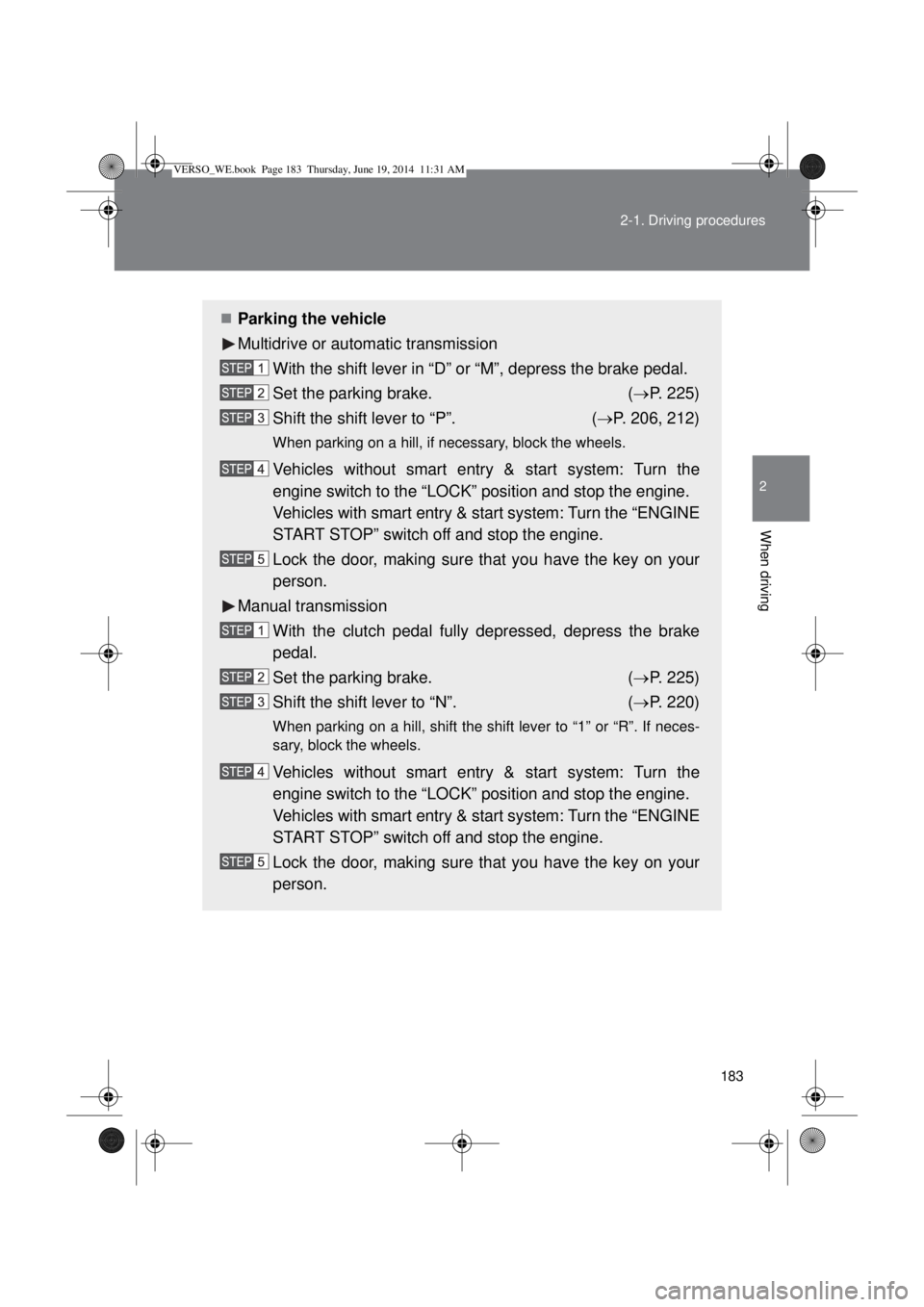Page 125 of 650
125 1-6. Theft deterrent system
1
Before driving
Vehicles with automatic air conditioning system
Vehicles without smart entry &
start system: The indicator
light flashes after the key has
been removed from the
engine switch to indicate that
the system is operating.
The indicator light stops flash-
ing after the registered key
has been inserted into the
engine switch to indicate that
the system has been can-
celed.
Vehicles with smart entry &
start system: The indicator
light flashes after the
“ENGINE START STOP”
switch has been turned off to
indicate that the system is
operating.
The indicator light stops flash-
ing after the “ENGINE START
STOP” switch has been turned
to ACCESSORY or IGNITION
ON mode to indicate that the
system has been canceled.
VERSO_WE.book Page 125 Thursday, June 19, 2014 11:31 AM
Page 126 of 650
126 1-6. Theft deterrent system
System maintenance
The vehicle has a maintenance-free type engine immobilizer system.
Conditions that may cause the system to malfunction
If the grip portion of the key is in contact with a metallic object
If the key is in close proximity to or touching a key to the security system
(key with a built-in transponder chip) of another vehicle
VERSO_WE.book Page 126 Thursday, June 19, 2014 11:31 AM
Page 139 of 650
139 1-6. Theft deterrent system
1
Before driving
Triggering of the alarm
The alarm may be triggered in the following situations. (Stopping the alarm
deactivates the alarm system.)
When the battery is disconnected
Be sure to cancel the alarm system.
If the battery is discharged before canceling the alarm, the system may be
triggered when the battery is reconnected.
Alarm-operated door lock
When the alarm is operating, the doors are locked automatically to pre-
vent intruders.
Do not leave the key inside the vehicle when the alarm is operating, and
make sure the key is not inside the vehicle when recharging or replacing
the battery.The doors are unlocked using the
mechanical key.
A person inside the vehicle opens a
door or hood.
The battery is recharged or replaced
when the vehicle is locked.
VERSO_WE.book Page 139 Thursday, June 19, 2014 11:31 AM
Page 155 of 650

155 1-7. Safety information
1
Before driving
CAUTION
SRS airbag precautions
Do not allow anyone to kneel on the
passenger seats toward the door or put
their head or hands outside the vehicle.
Do not attach anything to or lean any-
thing against areas such as the dash-
board, steering wheel pad or lower
portion of the instrument panel.
These items can become projectiles
when SRS driver, front passenger and
knee airbags deploy.
Vehicles without SRS curtain shield air-
bags: Do not attach anything to areas
such as a door, windshield glass and
side door glass.
Vehicles with SRS curtain shield air-
bags: Do not attach anything to areas
such as the door, windshield glass, side
door glass, front, center and rear pil-
lars, roof side rail or assist grip. (Except
for the speed limit label P. 563)
Vehicles without smart entry & start
system: Do not attach any heavy, sharp
or hard objects such as keys or acces-
sories to the key. The objects may
restrict the SRS knee airbag inflation or
be thrust into the driver’s seat area by
the force of the deploying airbag, thus
causing a danger.
VERSO_WE.book Page 155 Thursday, June 19, 2014 11:31 AM
Page 161 of 650
161 1-7. Safety information
1
Before driving
Key of letters inserted in the above table:
U: Suitable for “universal” category child restraint system approved
for the use in this mass group.
X: Not suitable seat position for children in this mass group.
The child restraint systems mentioned in the table may not be avail-
able outside of the EU area.
NOTE:
Other child restraint system which is different from the system men-
tioned in the table can be used, but the suitability of the systems must
be carefully checked with the child restraint system manufacturer
concerned and the seller of those seats.
VERSO_WE.book Page 161 Thursday, June 19, 2014 11:31 AM
Page 163 of 650

163 1-7. Safety information
1
Before driving
Key of letters inserted in the above table:
IUF: Suitable for ISOFIX forward child restraint systems of universal
category approved for the use in this mass group.
X: ISOFIX position not suitable for ISOFIX child restraint systems
in the mass group and/or size class.
The child restraint systems mentioned in the table may not be avail-
able outside of the EU area.
NOTE:
Other child restraint system which is different from the system men-
tioned in the table can be used, but the suitability of the systems must
be carefully checked with the child restraint system manufacturer
concerned and the seller of those seats.
When installing the child restraint system on the front passenger seat
adjust the following:
Selecting an appropriate child restraint system
Use a child restraint system appropriate for the child until the child
becomes large enough to properly wear the vehicle’s seat belt.
If the child is too large for a child restraint system, sit the child on a rear
seat and use the vehicle’s seat belt. (P. 96) The seat as far back as possible
The seatback to the most upright posi-
tion
The seat cushion to the highest position
(if equipped)
The seat belt height to the lowest posi-
tion
VERSO_WE.book Page 163 Thursday, June 19, 2014 11:31 AM
Page 179 of 650
179 1-7. Safety information
1
Before driving
Deactivating the front passenger airbag
Vehicles without smart entry &
start system: Insert the key into
the cylinder and turn to the
“OFF” position.
The “OFF” indicator light turns on
(only when the engine switch is in
the “ON” position).
Vehicles with smart entry & start
system: Insert the mechanical
key into the cylinder and rotate to
the “OFF” position.
The “OFF” indicator light turns on
(only when the “ENGINE START
STOP” switch is in IGNITION ON
mode).
“PASSENGER AIRBAG” indicator information
If any of the following problems occurs, it is possible that there is a malfunc-
tion in the system. Have the vehicle inspected by any authorized Toyota
dealer or repairer, or another duly qualified and equipped professional.
Neither “ON” nor “OFF” comes on.
The indicator does not change when the airbag manual on-off switch is
switched to the “ON” or “OFF” position.
VERSO_WE.book Page 179 Thursday, June 19, 2014 11:31 AM
Page 183 of 650

183 2-1. Driving procedures
2
When driving
Parking the vehicle
Multidrive or automatic transmission
With the shift lever in “D” or “M”, depress the brake pedal.
Set the parking brake. (P. 225)
Shift the shift lever to “P”. (P. 206, 212)
When parking on a hill, if necessary, block the wheels.
Vehicles without smart entry & start system: Turn the
engine switch to the “LOCK” position and stop the engine.
Vehicles with smart entry & start system: Turn the “ENGINE
START STOP” switch off and stop the engine.
Lock the door, making sure that you have the key on your
person.
Manual transmission
With the clutch pedal fully depressed, depress the brake
pedal.
Set the parking brake. (P. 225)
Shift the shift lever to “N”. (P. 220)
When parking on a hill, shift the shift lever to “1” or “R”. If neces-
sary, block the wheels.
Vehicles without smart entry & start system: Turn the
engine switch to the “LOCK” position and stop the engine.
Vehicles with smart entry & start system: Turn the “ENGINE
START STOP” switch off and stop the engine.
Lock the door, making sure that you have the key on your
person.
VERSO_WE.book Page 183 Thursday, June 19, 2014 11:31 AM